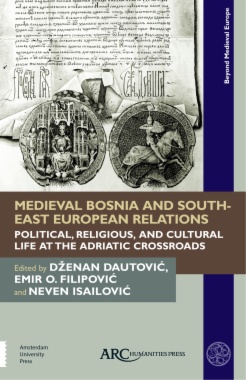<p >As a small, landlocked country, medieval Bosnia managed topreserve its individuality, characterized by religious plurality and by thepersistence of its own ancient customs. But its central position in the region,situated between east and west, and between Catholic and Orthodox Christianity,meant it was heavily influenced, both politically and culturally by theVenetian Republic, the Hungarian Kingdom, and the Byzantine Empire. Due to languageissues and scarcity of sources, this region has largely been overlooked bywestern historiography. This volume features contributions from an exciting newgeneration of medievalists, who are working to rectify this gap in thenarrative.</p>
- Cover
- Half-title
- Series information
- Title page
- Introduction
- Chapter 1. Bosnia and Croatia-Dalmatia in the Late Middle Ages: A Historical Perspective
- Croatian Rule of Bosnia—The Dominance of the Šubic Family (1301–1322)
- High Aspirations—The Reign of Stjepan II (1322–1353)
- Temporary Setback in the West—The Time of Ban Tvrtko (1353–1377)
- Seizing the Moment—The Western Policy of Kings Tvrtko I and Dabiša (1377–1395)
- “The World Did Not Spin and Turn This Much Since the Great Flood”—The Age of Hrvoje Vukcic (1398–1416)
- A Permeable Border—Croatia-Dalmatia and Bosnia between the Kingdom of Hungary and Venice (1416–1444)
- The Breach in Antimurale Christianitatis—In the Shadow of the Ottoman Threat (1444–1463)
- The Aftermath—Seeking Shelter in the West … or Among the Turks
- Conclusion
- Chapter 2. Relations Between the Bosnian Kingdom and the Serbian Despotate in a Regional Context
- Chapter 3. The Opposition Between Bulgaria and the Latin Empire of Constantinople
- Chapter 4. Ottoman Power Holders in the Balkans (1353–1580): A Case of Upward and Downward Elite Mobility
- The Socio-Genesis of Ottoman Rule in the Balkans (1353–1453)
- The Second Phase: Massive Investments Coordinated From the Centre
- Conclusions
- Chapter 5. Exploiting the Frontier—A Case Study: The Common Endeavour of Matthias Corvinus and Nicholas of Ilok in Late Medieva
- Setting the Possibilities
- The Path to Kingship
- The Solution to the Matrix
- A Link to the Crossroads
- Chapter 6. The Papacy and Marriage Practices in Medieval Bosnia
- Papal Dispensation for Bosnian Marriages
- Modo Bosignanorum—The Conundrum of the Bosnian Style of Marriage
- Interconfessional Marriages in Medieval Bosnia
- Conclusion
- Chapter 7. Ecclesiastical Reformer and Politician
- Magister, King’s Chancellor—Stephen
- Administrator, Reformer, Refounder—Bishop Stephen II of Zagreb
- Archbishop-Elect, Duke!
- Conclusions
- Select Bibliography
- Index

